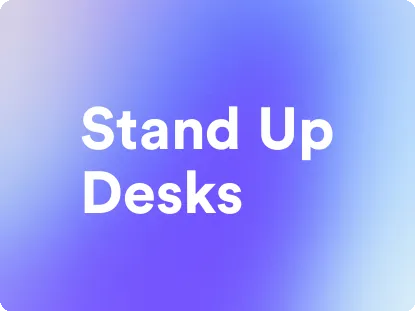Stand-Up Desks: A Comprehensive Guide to Productivity Enhancement
This guide will walk you through the essential elements of using stand up desks - the productivity method to keep your team productive and engaged.
Try Lark for Free
In the contemporary work landscape, the concept of stand-up desks has gained significant attention as a potential means of increasing productivity and promoting a healthier work environment. This detailed guide will explore the origins of stand-up desks, their potential benefits, and drawbacks, and provide practical advice for incorporating them into various work settings. Let's dive into the world of stand-up desks and uncover the multifaceted impacts they can have on the modern workplace.
What are Stand-Up Desks?
The Concept of Stand-Up Desks
The essence of stand-up desks lies in their fundamental departure from the traditional seated work setup. They offer an elevated platform that allows individuals to work while standing, fostering a more dynamic approach to completing tasks. This deviation from the sedentary norm is aimed at promoting movement and enhancing overall well-being.
Evolution of Stand-Up Desks
The concept of standing while working can be traced back to ancient civilizations, where tasks were performed in more versatile environments. Fast forward to the modern era, the design and functionality of stand-up desks have evolved significantly, catering to the diverse needs of contemporary professionals.
Types of Stand-Up Desks
- Fixed Height Desks: These desks are set at a single, non-adjustable height, offering a straightforward standing work platform.
- Adjustable Height Desks: This versatile option allows users to tailor the desk's height to their specific comfort preferences, enabling seamless transitions between sitting and standing.
The Origins of Stand-Up Desks
Historical Context
The roots of stand-up desks can be traced back to ancient Greece and the concept of the "lectern," where speakers delivered orations while standing.
Innovations and Influential Figures
In the 18th century, renowned figures such as Thomas Jefferson and Benjamin Franklin were known to use stand-up desks, recognizing the potential benefits of working in an upright position.
Adoption in Modern Work Environments
The resurgence of interest in stand-up desks gained momentum in the 21st century, fueled by increased awareness of the health implications associated with prolonged sitting.
Use Lark to unleash your team productivity.
Who Benefits from Stand-Up Desks?
Office Workers
Professionals in traditional office settings can utilize stand-up desks to inject movement into their workday, potentially combating the adverse effects of prolonged sitting.
Remote Workers
Individuals working from home or in remote settings can leverage stand-up desks to create an ergonomic and adaptable work environment, promoting health and productivity.
Professionals with Specific Health Needs
Individuals with specific health considerations, such as back pain or circulatory issues, may find relief and improved functionality through the use of stand-up desks.
Pros and Cons of Stand-Up Desks
Advantages
- Health Benefits: Standing while working can promote better posture, improve circulation, and potentially alleviate certain musculoskeletal issues.
- Increased Alertness: By allowing individuals to adjust their working position, stand-up desks may contribute to heightened alertness and attentiveness, potentially enhancing productivity.
- Potential for Increased Productivity: Some individuals report feeling more energized and focused when using stand-up desks, potentially increasing their efficiency.
Disadvantages
- Physical Fatigue: Prolonged standing may lead to physical fatigue and discomfort, particularly if users are not accustomed to this working posture.
- Potential Discomfort: Some individuals may experience initial discomfort when transitioning to a standing work setup, necessitating an adjustment period.
- Impact on Task Execution: Certain tasks may be less convenient or efficient when performed while standing, potentially posing challenges in certain work scenarios.
Learn more about Lark x Productivity
Getting Started with Stand-Up Desks
Workspace Assessment
Before integrating a stand-up desk into a workspace, individuals should assess their environment to ensure that the transition aligns with their specific work requirements and physical space constraints.
Choosing the Right Desk
Selecting an appropriate stand-up desk involves considering factors such as available space, ergonomic design, and adjustability to accommodate individual preferences.
Transitioning from Sitting to Standing
A gradual approach to transitioning from a seated to a standing work setup is recommended to allow the body to adapt to the change in posture, potentially minimizing discomfort.
Use Lark to unleash your team productivity.
Actionable Tips for Stand-Up Desks
- Utilizing Anti-Fatigue Mats: Investing in an anti-fatigue mat can reduce the physical strain associated with standing for extended periods, offering cushioning and support.
- Incorporating Ergonomic Accessories: Adding accessories such as footrests and supportive chairs for intermittent seated breaks can enhance overall comfort and promote better posture.
- Combining Standing with Active Sitting: Implementing active sitting options, such as stability balls or ergonomic stools, can provide dynamic support and encourage movement.
Do's and Dont's
| Do's | Dont's |
|---|---|
| Maintain good posture | Stand for prolonged periods without breaks |
| Adjust desk height to elbow level | Slouch or lean excessively |
| Use a supportive anti-fatigue mat | Stand continuously without movement breaks |
Conclusion
Stand-up desks present a compelling opportunity to transform sedentary work practices, offering potential benefits in terms of improved health, productivity, and overall well-being. By carefully considering individual needs and preferences, professionals can leverage stand-up desks as a versatile tool to enhance their work experience and vitality.
Use Lark to unleash your team productivity.
